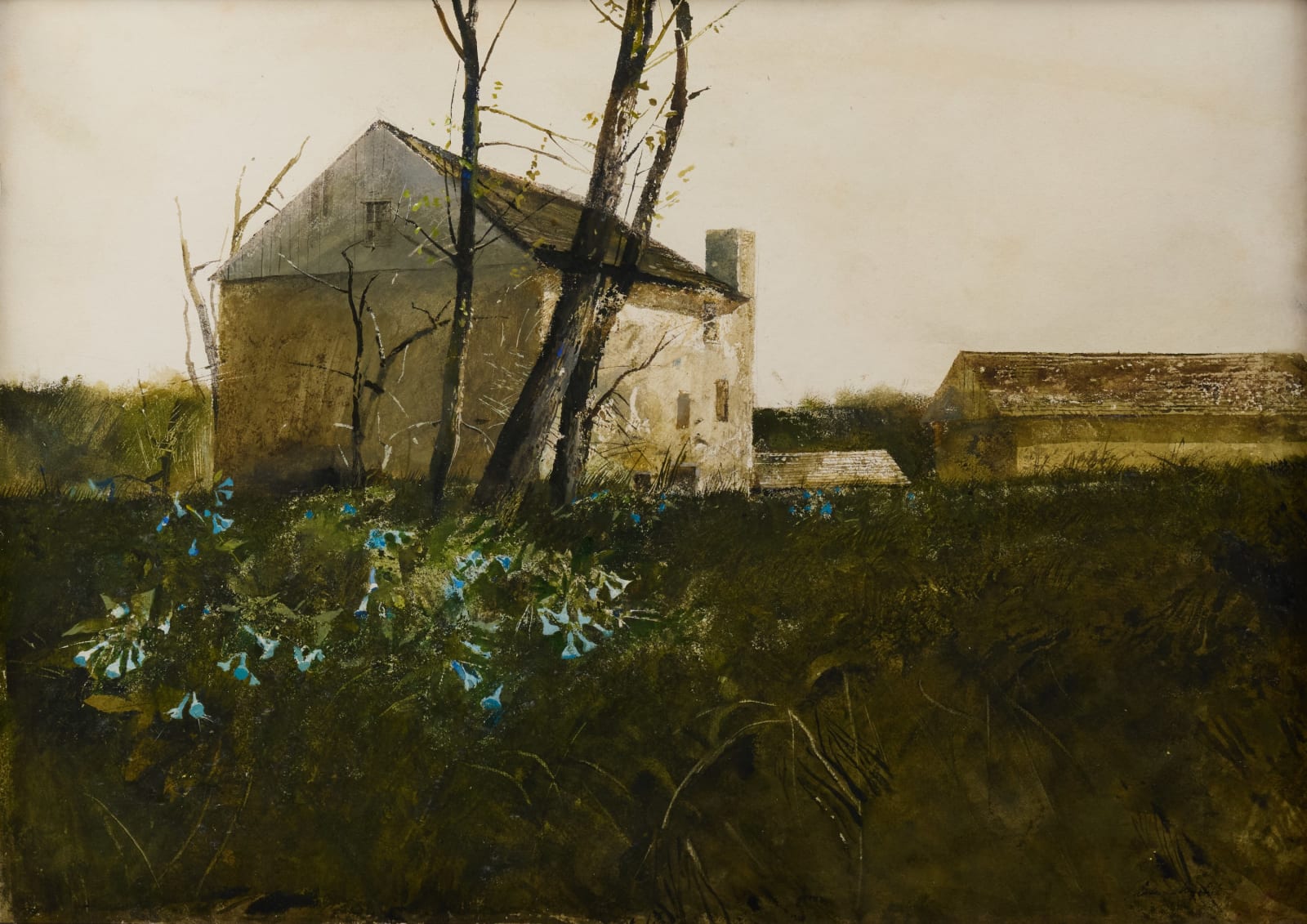Andrew Wyeth American, 1917-2009
54.6 x 76.2 cm
The Andrew & Betsy Wyeth Study Center of the Brandywine Museum of Art confirms that this object is recorded in Betsy James Wyeth’s files.
This was Andrew Wyeth's mill now, and it had been since 1958, when Betsy Wyeth undertook the years-long restoration of the historic Chadds Ford mill properties to make them the Wyeth family home. But the mill had two hundred fifty years of history that had intrigued the artist even from his childhood. Men died here, Wyeth knew; the imagined horrors of a young boy were heightened by the rattling and the rasping and the quaking of the building under the force of the great grinding stones, which had operated continuously until 1948. [1] The mill had always been the setting for Wyeth's imaginings of the bloody Battle of the Brandywine in September 1777. This particular scene he could even have envisioned, perhaps, as the bivouac of defeated commander General John Sullivan and his men at this very spot, where they took overwhelming cannon fire from the British and Hessians on the ridge opposite. Wyeth spoke of a history that was palpable, almost audible here, marveling to his biographer, Richard Meryman, that the very beams were embedded with cannon thunder. His most vivid fantasy, he told Meryman, was that the Redcoats had waded into the creek here, their rifles held high above their heads, and took the mill. Wyeth was steeped in the battle's history, he had the toy soldiers, and he owned historic officers' clothes; he even painted the miniature figures of British General Howe and the Hessians come to life on the window sill in his studio in what is a charming, childlike vision, The British at Brandywine (1961, Private Collection).
Betsy had hired George Heebner to restore the complex of buildings that the Wyeth's called collectively The Mill—the gristmill, a granary, and the miller's house, where the Wyeths' lived. And George was something of a man from another era—one part of this meticulous craftsman was always living in the eighteenth century as he worked to take The Mill back to that earlier time. [2] He and Betsy had even determined that George would return the gristmill to its working state, and George became an expert on not just the building's structure but on an early mill's mechanics as well. George kept the mill in working order as a point of pride for both the Wyeths and himself and for the enjoyment of a community that valued its past. When he dammed the creek to raise the water levels to a height that would adequately feed the enormous waterwheel, George unwittingly led the Wyeths into a thirteen-year-long fight with neighbors over water rights that reached a fever pitch in 1981, a contest of wills that Wyeth, the locals, and the New York Times, in reporting on the saga, wryly called the "Second Battle of Brandywine." [3] That year, 1981, Wyeth painted Heebner for the first time in a large tempera portrait of the man striding along the ridge above the mill properties, a painting of his own foot soldier now that the artist titled Battleground (Nelson-Atkins Museum of Art, Kansas City).
—Patricia Junker
[1] Richard Meryman recounts what Wyeth told him of his fantastical associations here; Meryman, Andrew Wyeth: A Secret Life (New York: HarperPerennial, 1998), pp. 314-315.
[2] See Wyeth's accounting of the work Heebner did at The Mill in his entry on the portrait Battleground, in Thomas Hoving, Andrew Wyeth: Autobiography (Boston: Bulfinch Press for the Nelson-Atkins Museum of Art, 1995), p. 153.
[3] William Robbins, "Wyeth and Neighbor Struggle Over Dam and Culvert," New York Times, September 4, 1981: Section A, p. 6.
Provenance
The artist; to[M. Knoedler & Co., Inc, New York]; to
Private collection, New Jersey; to
The estate of the above, 2025 until the present
Exhibitions
Albright-Knox Art Gallery, Buffalo, New York, Andrew Wyeth: Temperas, Water Colors and Drawings, November 2-December 9, 1962, no. 280Peck School, Morristown, New Jersey, Three Generations of Wyeth, 1983, no. 543
A.C.A. Gallery, New York, Andrew Wyeth, January 14-February 27, 1993, no. 1096
Subscribe to our mailing list to receive updates from the gallery
* denotes required fields
We will process the personal data you have supplied in accordance with our privacy policy (available on request). You can unsubscribe or change your preferences at any time by clicking the link in our emails.

